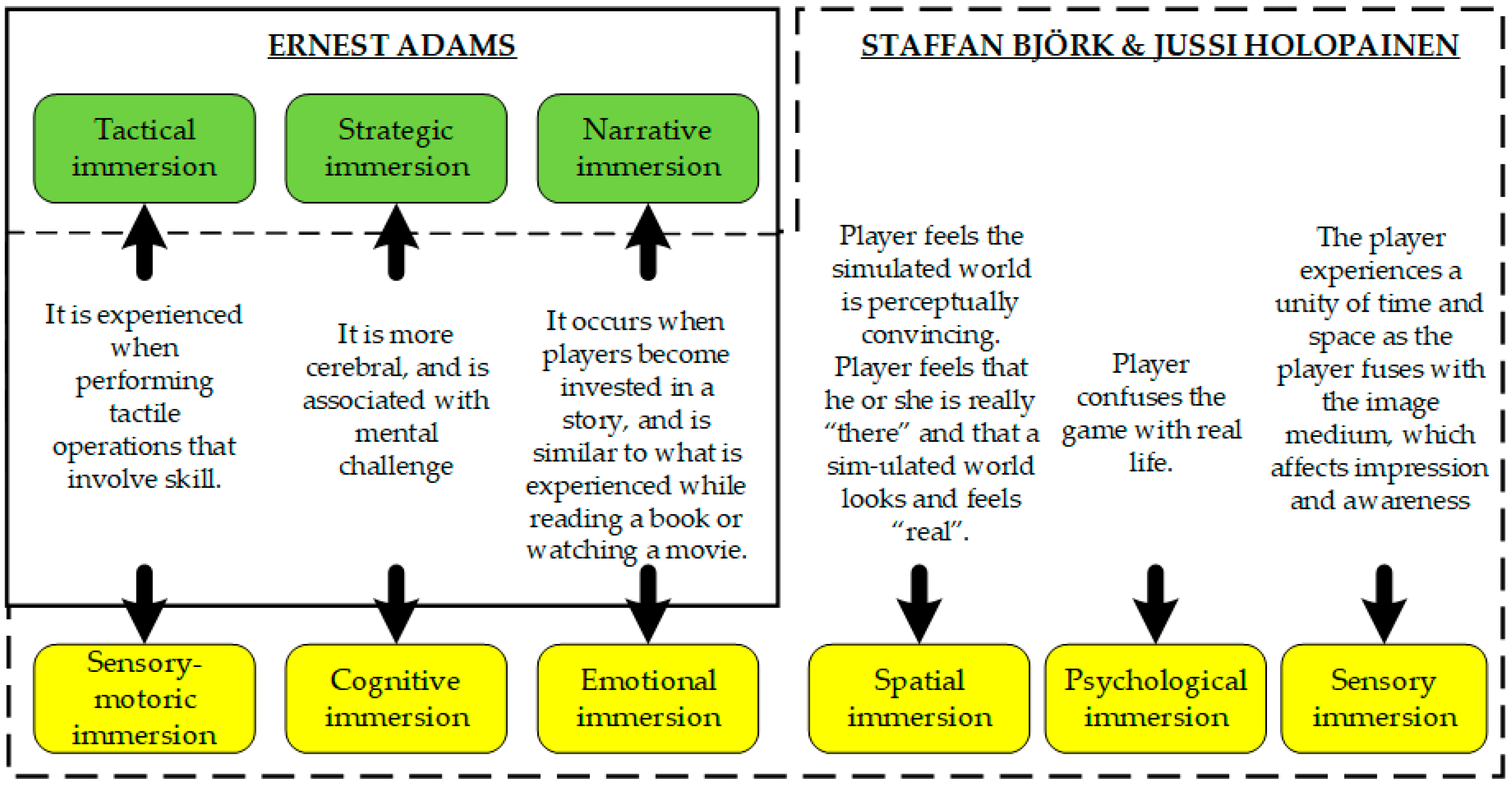Development of a Virtual Reality Tool for Train Crew Training
Abstract
:1. Introduction
2. Literature Review
2.1. Immersive Virtual Reality (IVR)
2.2. Use of Virtual Reality in Training
- It could be time-consuming due to the efforts and time needed to set up the real-world training site and to travel to the site;
- It could be expensive due to the cost of preparing real-world training materials and hiring human coaches;
- It could be unappealing and unintuitive due to the lack of visual hints, such as 3D animations for illustrating skills and processes;
- It could not be possible to train some skills in the real world, such as emergency procedures that can only be safely trained in simulators.
- The possibility of using an increased number of training scenarios while reducing training costs: This is because VR training scenarios primarily involve computer-generated 3D graphics. Developers can, therefore, create various scenarios from existing 3D resources (both proprietary and available online) that can be reused to train different people.
- The possibility of training in the comfort of one’s own space: This is especially important in cases where the trainee may feel uncomfortable about their actions in the real-world training process due to the presence of other participants (observers). At the same time, the same tool can be used in training situations that need to happen in the presence of instructors as they need to provide early feedback on the trainee’s performance and alert the trainee to issues that they may be experiencing, including negative trends in their performance.
- Increased involvement in training—immersive environments and 3D representations make users more interested and committed to their training;
- Speed—workers can obtain and retain information efficiently due to the creative and attractive method that this digital tool offers. Many studies emphasize that VR allows for training through emotional responses, the best method to not forget what has been learned;
- Measurability—training is carried out in computer-generated environments; thus, researchers can quickly obtain any required statistics, such as the time it takes an operator to carry out a particular activity, the most common accidents, or the procedure with less difficulty;
- Reduction in work accidents—VR offers a much safer scenario where users can practice obtaining the necessary skills without risking their integrity;
- Personalization—scenarios can adapt to the requirements of each worker;
- Reduction in costs—VR helps to reduce infrastructure, materials, time, and personnel expenses that are required by real simulations.
- The most common approach involved using some objective method (e.g., knowledge test): such methods were applied in 82% of the reviewed studies;
- The subjective evaluation of the training tool, learning outcomes, motivation, or other psychological constructs was also used in 72% of the studies;
- Observation by an expert as a form of assessment of learning effectiveness was used sparingly (6%). It was primarily used where objective assessment methods could not be applied or for the qualitative evaluation of learners’ reactions during learning;
- Physiological measurements were the least frequently applied (3%).
- First responder training (e.g., police officers, firefighters, and emergency medical services);
- Medical training;
- Military training;
- Transportation sector;
- Workforce training;
- Interpersonal skills training (in particular, openness, empathy, verbal, and nonverbal communication).
3. Methodology
4. Results
4.1. Scope of Training Using Virtual Reality
4.2. Analysis of the Processing Times of Training Activities
- The time intensity of the execution of individual operations;
- Identification of activities with high variation in execution times, which may indicate a strong dependence of the execution of the operation on the predisposition of the trainee;
- Identification of activities with low variation in execution times but a high parameter of average execution time—identification of activities that are difficult in virtual reality, regardless of the predisposition of trainees.
- Unfolding the platform and elevator wings;
- Closing the elevator and exiting the train;
- Lowering the elevator hydraulically using two valves;
- Opening the lid and lever, stowing the key in the tray, and opening the entire elevator.
- Introducing a uniform way of locating the square-type key for closed/open positions: e.g., a key in the vertical position means that the lock in question is open, and the horizontal position means it is closed;
- Verifying the correct direction of turning the square-type key to open/close locks;
- Entering and exiting the carriage smoothly and not jumping with the entry button;
- Opening/closing of doors should be implemented, considering the operation of buttons;
- The functionality of the door locking lock should be reproduced;
- The elevator’s location and immediate surroundings should correspond to the location of the actual vehicle;
- The buttons for opening/closing the doors and the handle for opening the elevator underneath them should be placed a little higher;
- The visible edge of the elevator cover should be added so that the edge hints at where to grab it;
- On the front of the elevator platform, there is a safety device that automatically lowers upon contact with the platform; its functionality should be recreated;
- The step under the door should extend and retract, adhering to reality;
- The ergonomics of unscrewing the valves for manually lowering the elevator needs improvement.
4.3. Fitting a Training Strategy
- Strategy 1 (ST1)—individual guidance of one trainee by one instructor—the instructor explains step by step what to do;
- Strategy 2 (ST2)—the trainee uses a storyboard describing the steps after a prior observation of the instructor’s demonstration—instructor support is limited;
- Strategy 3 (ST3)—instructor adaptively supports on request—people observed once by the instructor and once by another participant;
- Strategy 4 (ST4)—instructor adaptively supports on request—individuals observed the instructor once and another participant twice.
- The execution time of the first iteration of the tasks is longer if the trainee is to self-learn from the available materials and after only one observation of the activity;
- The time to complete the first iteration of the virtual exercise decreases with the number of observed iterations, and after two iterations of the observation of other trainees and one instructor, it reaches the level of individual guidance of one trainee by one instructor;
- The most time-disadvantageous case is to have trainees perform the exercise on their own after a single observation by the instructor (only with the support of training materials and limited assistance from the instructor);
- The variability in completion times as expressed by the standard deviation decreases most significantly after a single observation of other trainees; therefore, the prediction of exercise completion times becomes more precise at a more advanced stage of training.
5. Discussion
- Increased activity of participants during the training and increased involvement in the implementation of the tasks assigned to them;
- Greater emotions accompanying the implementation of tasks, which had a positive impact on remembering the scope of performed operations;
- Ability to adapt scenarios to the needs of training participants.
6. Conclusions
Author Contributions
Funding
Institutional Review Board Statement
Informed Consent Statement
Data Availability Statement
Conflicts of Interest
References
- Available online: https://Bulldogjob.Pl/for-Employers/Blog/Zmora-Rekrutacji-Naszych-Czasow-Rotacja-Pracownikow-Jak-Ja-Pokonac (accessed on 15 June 2023).
- Szaciłło, L.; Jacyna, M.; Szczepański, E.; Izdebski, M. Risk Assessment for Rail Freight Transport Operations. Eksploat. I Niezawodn.–Maint. Reliab. 2021, 23, 476–488. [Google Scholar] [CrossRef]
- Tubis, A.; Haładyn, S.; Kierzkowski, A.; Kisiel, T.; Restel, F.; Wolniewicz, Ł. Analysis of Human Errors in the Cargo Logistics Process in the Airport Zone. In Proceedings of the 16th International Conference on Probabilistic Safety Assessment and Management, PSAM 2022, Honolulu, HI, USA, 26 June–1 July 2022. [Google Scholar]
- Xie, B.; Liu, H.; Alghofaili, R.; Zhang, Y.; Jiang, Y.; Lobo, F.D.; Li, C.; Li, W.; Huang, H.; Akdere, M.; et al. A Review on Virtual Reality Skill Training Applications. Front. Virtual Real. 2021, 2, 645153. [Google Scholar] [CrossRef]
- Guo, K.; Zhang, L. Simulation-Based Passenger Evacuation Optimization in Metro Stations Considering Multi-Objectives. Autom. Constr. 2022, 133, 104010. [Google Scholar] [CrossRef]
- Wang, Z.; Mao, Z.; Li, Y.; Yu, L.; Zou, L. VR-Based Fire Evacuation in Underground Rail Station Considering Staff’s Behaviors: Model, System Development and Experiment. Virtual Real. 2023, 27, 1145–1155. [Google Scholar] [CrossRef]
- Yu, S. Application of VR Intelligent Technology in Fire Evacuation Simulation of Urban Rail Transit Station. Procedia Comput. Sci. 2022, 208, 223–230. [Google Scholar] [CrossRef]
- Vanichchanunt, P.; Tanmalaporn, T.; Suthamvijit, C.; Noisri, S.; Wuttisittikulkij, L.; Pongyart, W.; Paripurana, S. Virtual Reality for Railway Signaling System Training. In Proceedings of the 2023 20th International Conference on Electrical Engineering/Electronics, Computer, Telecommunications and Information Technology (ECTI-CON), Nakhon Phanom, Thailand, 9–12 May 2023; pp. 1–4. [Google Scholar]
- Randeniya, N.; Ranjha, S.; Kulkarni, A.; Lu, G. Virtual Reality Based Maintenance Training Effectiveness Measures—A Novel Approach for Rail Industry. In Proceedings of the 2019 IEEE 28th International Symposium on Industrial Electronics (ISIE), Vancouver, BC, Canada, 12–14 June 2019; pp. 1605–1610. [Google Scholar]
- Shen, Z.; Zou, J.; Chen, W.; An, X. VR Panoramic Video Technology and Its Application in Rail Transit Personnel Training in the 5G Era. In Proceedings of the 2020 5th International Conference on Mechanical, Control and Computer Engineering (ICMCCE), Harbin, China, 25–27 December 2020; pp. 2369–2373. [Google Scholar]
- Sun, R.; Wu, Y.J.; Cai, Q. The Effect of a Virtual Reality Learning Environment on Learners’ Spatial Ability. Virtual Real. 2019, 23, 385–398. [Google Scholar] [CrossRef]
- Jensen, L.; Konradsen, F. A Review of the Use of Virtual Reality Head-Mounted Displays in Education and Training. Educ. Inf. Technol. 2018, 23, 1515–1529. [Google Scholar] [CrossRef]
- Ryan, M.-L. Narrative as Virtual Reality 2: Revisiting Immersion and Interactivity in Literature and Electronic Media; JHU Press: Baltimore, MD, USA, 2015. [Google Scholar]
- Walsh, K.R.; Pawlowski, S.D. Virtual Reality: A Technology in Need of IS Research. Commun. Assoc. Inf. Syst. 2002, 8, 20. [Google Scholar] [CrossRef]
- Steuer, J. Defining Virtual Reality: Dimensions Determining Telepresence. J. Commun. 1992, 42, 73–93. [Google Scholar] [CrossRef]
- Mandal, S. Brief Introduction of Virtual Reality & Its Challenges. Int. J. Sci. Eng. Res. 2013, 4, 304–309. [Google Scholar]
- Lee, E.A.-L.; Wong, K.W. A Review of Using Virtual Reality for Learning. In Transactions on Edutainment I. Lecture Notes in Computer Science; Pan, Z., Cheok, A.D., Müller, W., El Rhalibi, A., Eds.; Springer: Berlin/Heidelberg, Germany, 2008; Volume 5080, pp. 231–241. [Google Scholar]
- Mao, R.Q.; Lan, L.; Kay, J.; Lohre, R.; Ayeni, O.R.; Goel, D.P.; de Sa, D. Immersive Virtual Reality for Surgical Training: A Systematic Review. J. Surg. Res. 2021, 268, 40–58. [Google Scholar] [CrossRef] [PubMed]
- Moorthy, K.; Munz, Y.; Adams, S.; Pandey, V.; Darzi, A. A Human Factors Analysis of Technical and Team Skills Among Surgical Trainees During Procedural Simulations in a Simulated Operating Theatre. Ann. Surg. 2005, 242, 631–639. [Google Scholar] [CrossRef] [PubMed]
- Radianti, J.; Majchrzak, T.A.; Fromm, J.; Wohlgenannt, I. A Systematic Review of Immersive Virtual Reality Applications for Higher Education: Design Elements, Lessons Learned, and Research Agenda. Comput. Educ. 2020, 147, 103778. [Google Scholar] [CrossRef]
- Janßen, D.; Tummel, C.; Richert, A.; Isenhardt, I. Towards Measuring User Experience, Activation and Task Performance in Immersive Virtual Learning Environments for Students. In Immersive Learning Research Network; Springer: Berlin/Heidelberg, Germany, 2016; pp. 45–58. [Google Scholar]
- Adams, E. The Designer’s Notebook: Postmodernism and the 3 Types of Immersion; Game Developer: London, UK, 2004. [Google Scholar]
- Bjork, S.; Holopainen, J. Patterns in Game Design; Charles River Media: Needham, MA, USA, 2005. [Google Scholar]
- Rogers, S. Virtual Reality: The Learning Aid of the 21st Century. Forbes 2019. Available online: https://www.forbes.com/sites/solrogers/2019/03/15/virtual-reality-the-learning-aid-of-the-21st-century/?sh=16e98e8a139b (accessed on 1 June 2023).
- Krokos, E.; Plaisant, C.; Varshney, A. Virtual Memory Palaces: Immersion Aids Recall. Virtual Real. 2019, 23, 1–15. [Google Scholar] [CrossRef]
- Radhakrishnan, U.; Koumaditis, K.; Chinello, F. A Systematic Review of Immersive Virtual Reality for Industrial Skills Training. Behav. Inf. Technol. 2021, 40, 1310–1339. [Google Scholar] [CrossRef]
- Tabbron, G.; Yang, J. The Interaction between Technical and Vocational Education and Training (TVET) and Economic Development in Advanced Countries. Int. J. Educ. Dev. 1997, 17, 323–334. [Google Scholar] [CrossRef]
- Falck, A.-C.; Örtengren, R.; Högberg, D. The Impact of Poor Assembly Ergonomics on Product Quality: A Cost-Benefit Analysis in Car Manufacturing. Hum. Factors Ergon. Manuf. Serv. Ind. 2010, 20, 24–41. [Google Scholar] [CrossRef]
- Bowyer, M.W.; Streete, K.A.; Muniz, G.M.; Liu, A.V. Immersive Virtual Environments for Medical Training. Semin Colon Rectal Surg. 2008, 19, 90–97. [Google Scholar] [CrossRef]
- Backlund, P.; Engstrom, H.; Hammar, C.; Johannesson, M.; Lebram, M. Sidh—A Game Based Firefighter Training Simulation. In Proceedings of the 2007 11th International Conference Information Visualization (IV ’07), Zurich, Switzerland, 4–6 July 2007; pp. 899–907. [Google Scholar]
- Li, C.; Liang, W.; Quigley, C.; Zhao, Y.; Yu, L.-F. Earthquake Safety Training through Virtual Drills. IEEE Trans. Vis. Comput. Graph. 2017, 23, 1275–1284. [Google Scholar] [CrossRef]
- Howard, M.C.; Gutworth, M.B.; Jacobs, R.R. A Meta-Analysis of Virtual Reality Training Programs. Comput. Hum. Behav. 2021, 121, 106808. [Google Scholar] [CrossRef]
- Rupasinghe, T.D.; Kurz, M.E.; Washburn, C.; Gramopadhye, A.K. Virtual Reality Training Integrated Curriculum: An Aircraft Maintenance Technology (AMT) Education Perspective. Int. J. Eng. Educ. 2011, 27, 778–788. [Google Scholar]
- Moreno, P.; Mayer, R.E. Virtual Reality and Learning: Cognitive and Motivational Effects of Students’ Sense of Presence. Proc. Hum.-Comput. Interact. 2001, 6567. Available online: https://citeseerx.ist.psu.edu/document?repid=rep1&type=pdf&doi=ac051f0f9452bc4730be682f4629d92f7f6b071d (accessed on 1 June 2023).
- Naranjo, J.E.; Sanchez, D.G.; Robalino-Lopez, A.; Robalino-Lopez, P.; Alarcon-Ortiz, A.; Garcia, M.V. A Scoping Review on Virtual Reality-Based Industrial Training. Appl. Sci. 2020, 10, 8224. [Google Scholar] [CrossRef]
- Strojny, P.; Dużmańska-Misiarczyk, N. Measuring the Effectiveness of Virtual Training: A Systematic Review. Comput. Educ. X Real. 2023, 2, 100006. [Google Scholar] [CrossRef]
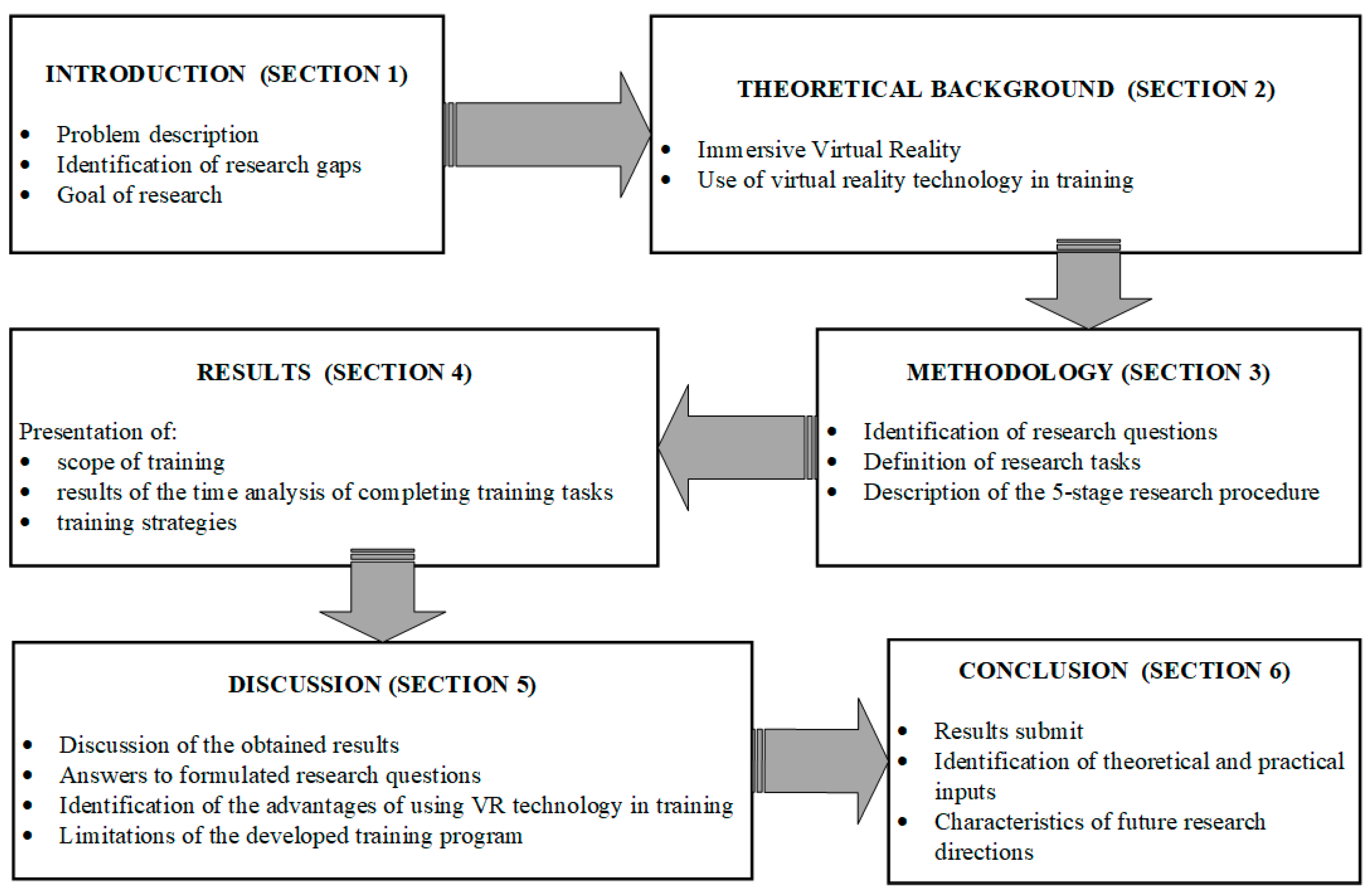
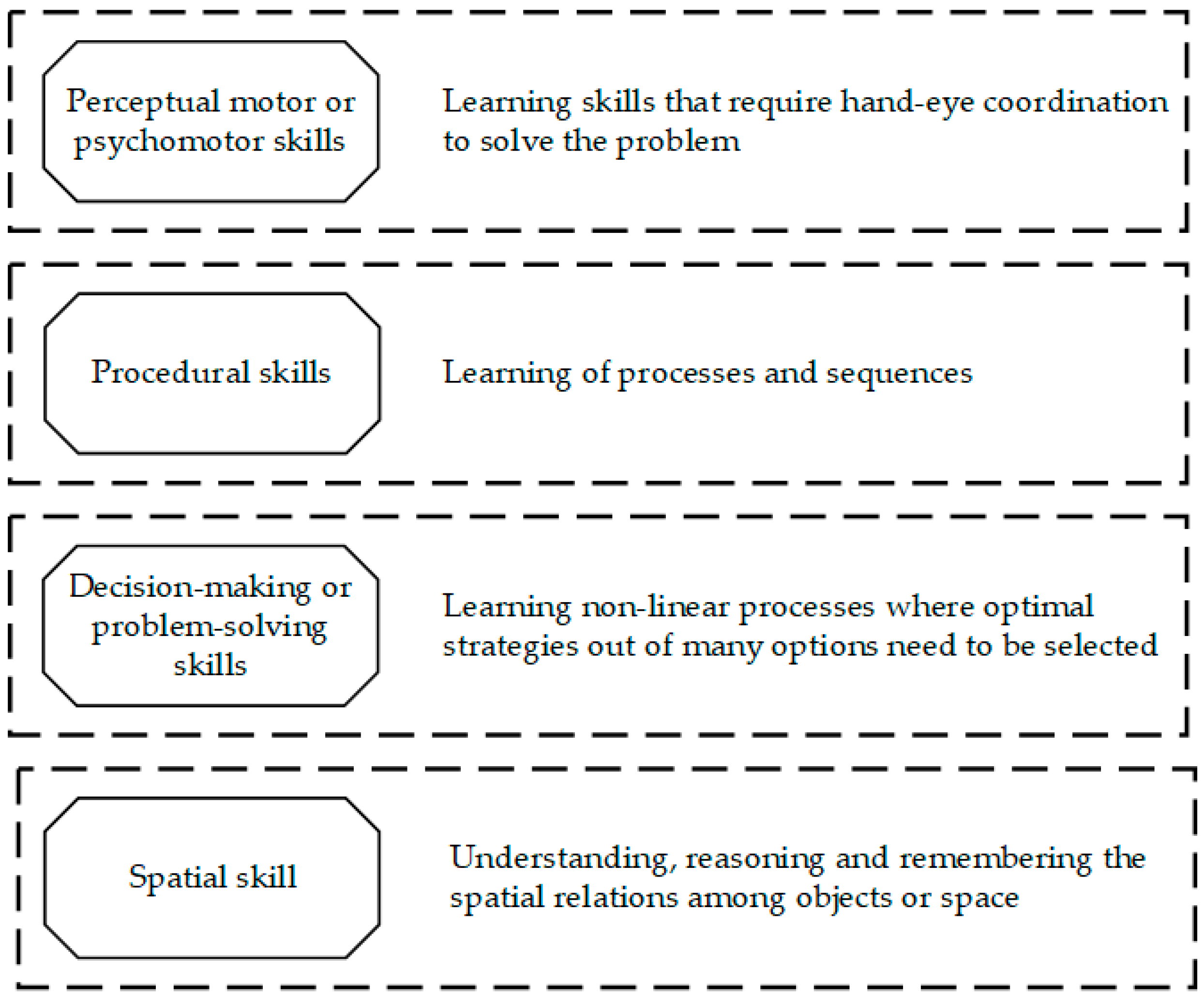
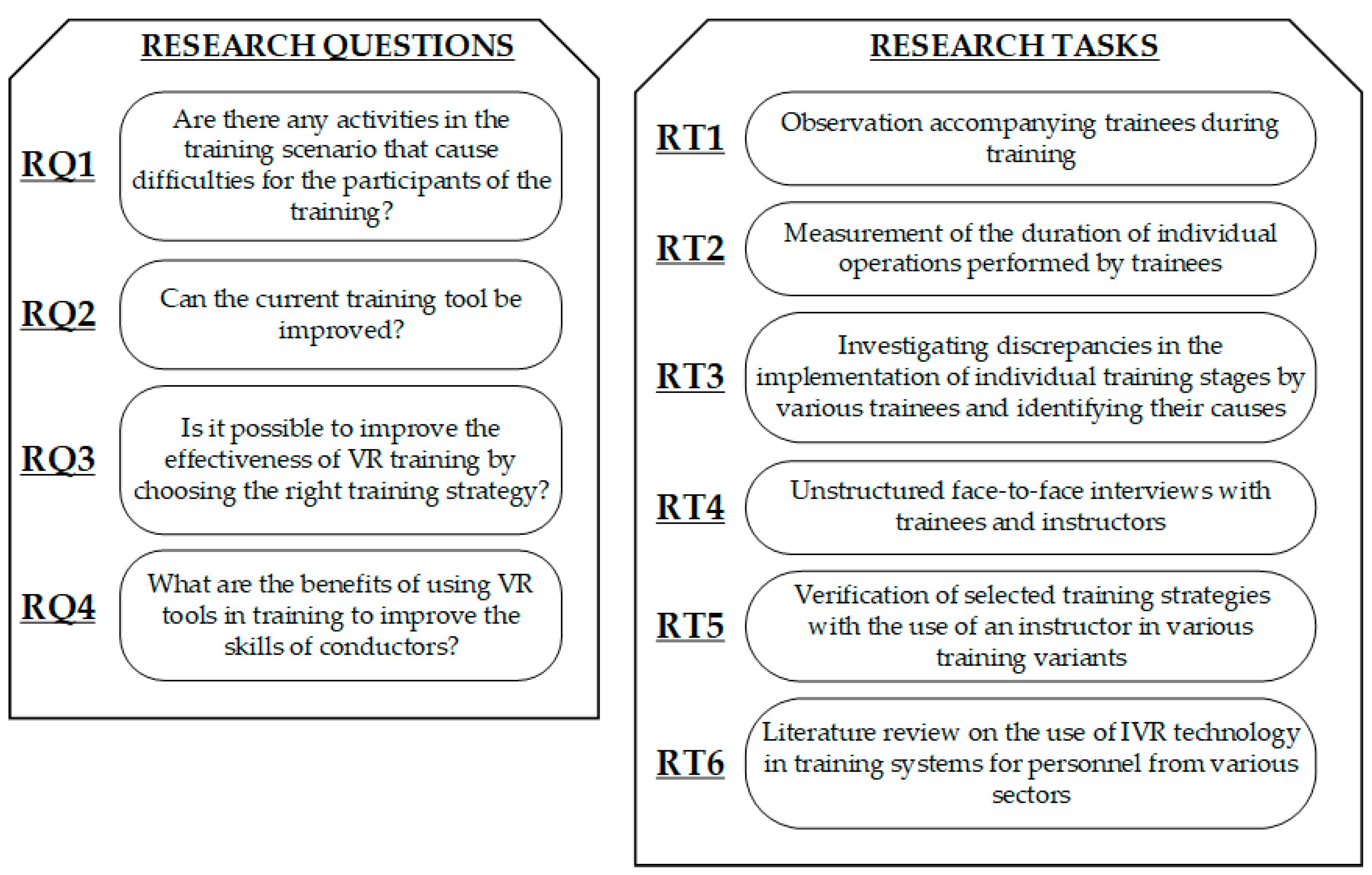


| Symbol | Activities | Visualization |
|---|---|---|
| A1 | Taking a board with the description of the procedure and carrying it under the train | 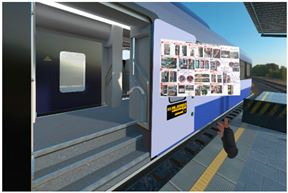 |
| A2 | Opening a tray and retrieving the square key |  |
| A3 | Opening the lid and lever, storing the key in the tray, and opening the entire elevator | 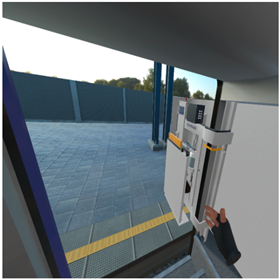 |
| A4 | Unfolding the platform and wings of the elevator and securing the carriage from rolling away from the side of the carriage | 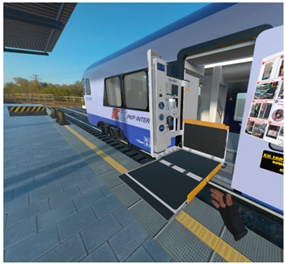 |
| A5 | Lowering the elevator to the station platform level using the remote control | 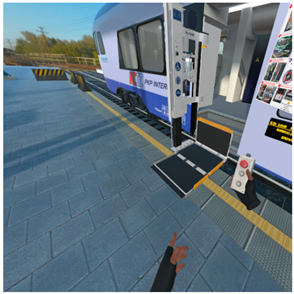 |
| A6 | Raising the elevator by remote control |  |
| A7 | Lowering the elevator hydraulically using two valves |  |
| A8 | Elevator raising with manual lever | 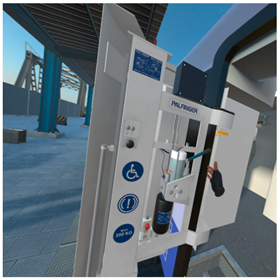 |
| A9 | Closing the elevator and exiting the train |  |
| Symbol | Activity | Average (min) | St. Dev. (min) | Variation Coef. (-) |
|---|---|---|---|---|
| A4 | Unfolding the platform and wings of the elevator and securing the carriage from rolling away from the side of the carriage | 03:22 | 03:56 | 1.17 |
| A9 | Closing the elevator and exiting the train | 03:35 | 03:25 | 0.95 |
| A7 | Lowering the elevator hydraulically using two valves | 02:16 | 01:50 | 0.81 |
| A2 | Opening a tray and retrieving the square key | 01:47 | 01:23 | 0.77 |
| A5 | Lowering the elevator to the station platform level using the remote control | 01:19 | 01:00 | 0.76 |
| A3 | Opening the lid and lever, storing the key in the tray, and opening the entire elevator | 03:15 | 02:27 | 0.75 |
| A6 | Raising the elevator by remote control | 01:14 | 00:54 | 0.73 |
| A8 | Elevator raising with manual lever | 02:24 | 01:29 | 0.62 |
| A1 | Taking a board with the description of the procedure and carrying it under the train | 00:33 | 00:13 | 0.41 |
| Comparing | Statistics of VR Tool Use | ||
|---|---|---|---|
| Average (min) | St. Dev. (min) | Variation Coef. (-) | |
| VR and gaming experience | 11:42 | 02:11 | 0.19 |
| VR but no gaming experience | 11:46 | 04:58 | 0.42 |
| No VR but gaming experience | 17:11 | 07:03 | 0.41 |
| No VR and no gaming experience | 18:47 | 05:38 | 0.30 |
| Statistical Parameters | ST1 | ST2 | ST3 | ST4 |
|---|---|---|---|---|
| Group | 1 | 2 | 3 | 4 |
| Sample size | 12 | 13 | 12 | 11 |
| Mean (mm: ss) | 14:05 | 19:26 | 15:44 | 13:50 |
| Std. deviation (mm: ss) | 08:57 | 08:16 | 01:55 | 01:39 |
| Hypothesis H0 | ||||
| t-statistics | 1.49 | 1.45 | 2.42 | 0.09 |
| Reject of H0? | yes | yes | yes | no |
| Critical t-quantile value | 1.32 | |||
| Hypothesis H0 | ||||
| F-statistics | 1.18 | 18.45 | 1.33 | 28.93 |
| Critical F-quantile value | 2.22 | |||
| Reject of H0? | no | yes | no | yes |
| Stage | Instructor 1 | Active Participants | Passive Participants | Estimated Net Time = Mean + Std. Deviation (min) |
|---|---|---|---|---|
| 1 | Demonstrates the operation of equipment and performs exercise activities in virtual reality | none | They observe, together on a large screen, the instructor’s virtual activity and the instructor’s physical activity | 5 |
| 2 | The instructor guides one trainee by explaining the tasks to him step by step | 1—conducted individually by the instructor | They observe, together on a large screen, the virtual activity of the trainee, ask questions, and listen to concerns | 23 |
| 3 | Instructor adaptively supports participants in virtual reality, prompts upon request | 2—conducted adaptively | They observe, divided into two subgroups, the virtual activity of one of the two trainees on dedicated screens, asking questions and listening to concerns | 17 |
| 4 | Instructor adaptively supports participants in virtual reality, prompts upon request | 3–4—conducted adaptively | They observe, with divisions into three/four subgroups, each virtual activity of one of the trainees on dedicated screens, ask questions, and listen to concerns | 14 |
| 5 | Instructor adaptively supports participants in virtual reality, prompts upon request | 4—conducted adaptively | They observe, with a division of four subgroups, each virtual activity of one of the trainees on dedicated screens, ask questions, and listen to concerns | 14 |
| Total training time for ten participants (min) | 73 |
Disclaimer/Publisher’s Note: The statements, opinions and data contained in all publications are solely those of the individual author(s) and contributor(s) and not of MDPI and/or the editor(s). MDPI and/or the editor(s) disclaim responsibility for any injury to people or property resulting from any ideas, methods, instructions or products referred to in the content. |
© 2023 by the authors. Licensee MDPI, Basel, Switzerland. This article is an open access article distributed under the terms and conditions of the Creative Commons Attribution (CC BY) license (https://creativecommons.org/licenses/by/4.0/).
Share and Cite
Tubis, A.A.; Restel, F.; Jodejko-Pietruczuk, A. Development of a Virtual Reality Tool for Train Crew Training. Appl. Sci. 2023, 13, 11415. https://doi.org/10.3390/app132011415
Tubis AA, Restel F, Jodejko-Pietruczuk A. Development of a Virtual Reality Tool for Train Crew Training. Applied Sciences. 2023; 13(20):11415. https://doi.org/10.3390/app132011415
Chicago/Turabian StyleTubis, Agnieszka A., Franciszek Restel, and Anna Jodejko-Pietruczuk. 2023. "Development of a Virtual Reality Tool for Train Crew Training" Applied Sciences 13, no. 20: 11415. https://doi.org/10.3390/app132011415
APA StyleTubis, A. A., Restel, F., & Jodejko-Pietruczuk, A. (2023). Development of a Virtual Reality Tool for Train Crew Training. Applied Sciences, 13(20), 11415. https://doi.org/10.3390/app132011415






